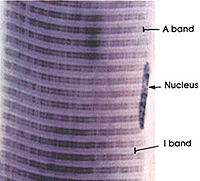Skeletal or Striated Muscle
The most characteristic features of
skeletal muscle are large, multinucleate fibers with
cross-striations. Remember that in muscle, fibers are actually
multinucleated cells. In the slides of muscle, notice that the
perimysium is the loose connective tissue between the fascicles. Iif
epimysium is present, observe its dense irregular connective tissue.
Clinical note: Exercise or increased use of specific
muscles produce hypertrophy or increased fiber size, while disuse
results in muscle atrophy. One form of the hereditary disease
muscular dystrophy, in which fibers do not mature properly or
survive, results from a defect in the gene for dystrophin, a large
protein with poorly understood functions located just inside the
sarcolemma.
Examine the striations on
longitudinally cut fibers:
- Identify A bands and I bands and
- Be sure you understand what
these bands represent in terms of sarcoplasmic organization
(Figs. 10-8 through 10-12).
What are the functions of the
endomysium and perimysium?
Most skeletal muscle associated with the GI tract is smooth, not
skeletal. Why are lingual muscles not composed of smooth muscle?
On to smooth muscle? |